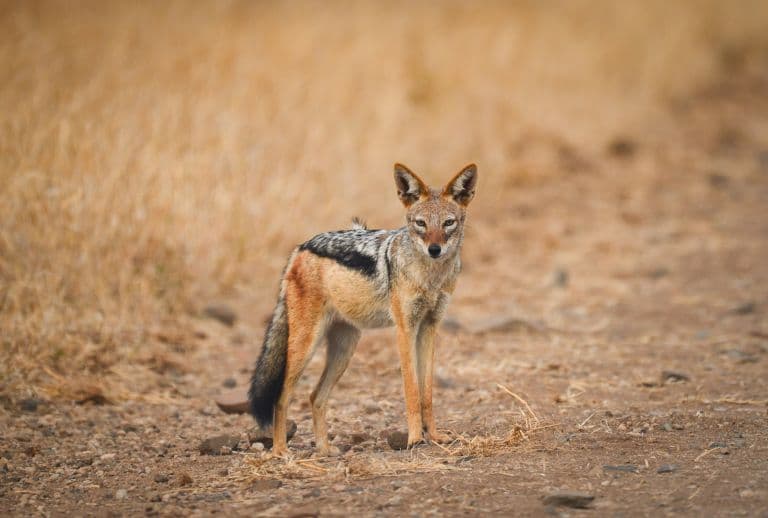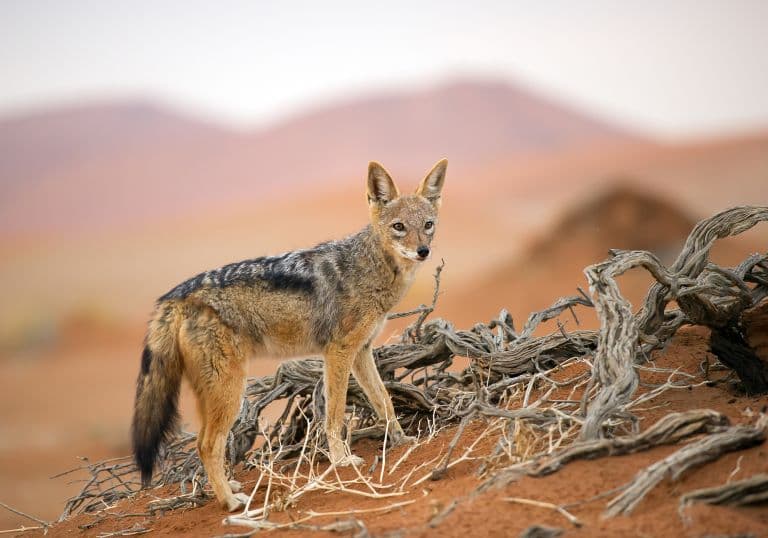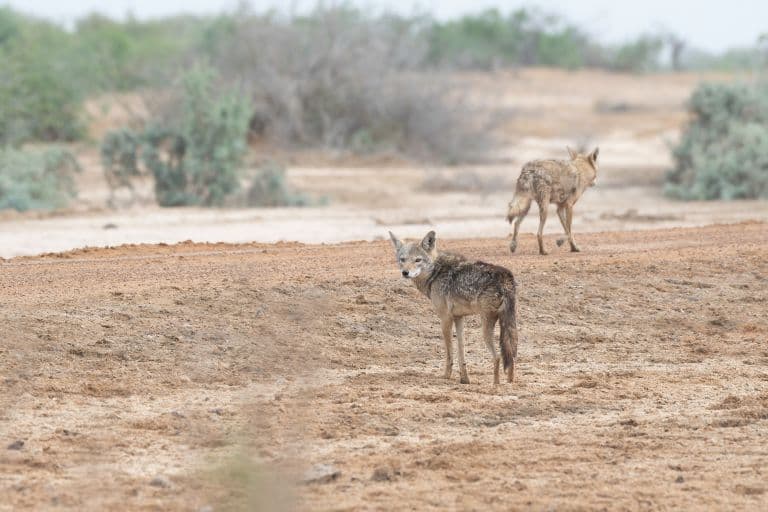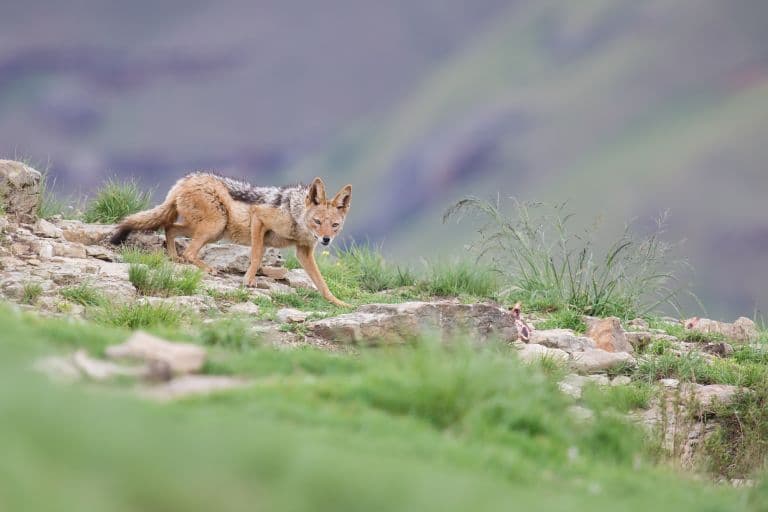Jackal Profile
Jackals are lightly built ‘dog-like’ carnivores that are native to both Africa and Eurasia.
Mesopredators occupy a critical mid-way point between the charismatic apex predators and the world of small invertebrates and detritivores in the trophic web. Many have adopted similar characteristics despite being unrelated to one another, carved out by the demands of their environment to maintain both upward and downward selective pressure on the members of their community.
Jackals are a great example of this. Once thought to be a subset of the genus Canis, it’s now clear that the similarities between the two genera of jackal have emerged independently, and this mid-range niche has created two very significant and very similar dog-like solutions.

Jackal Facts Overview
| Habitat: | Mostly savannas and woodlands but also marshes, deserts, grasslands |
| Location: | Central and Southern Africa, Southeastern Europe, Middle East, South Asia |
| Lifespan: | Around 9 years in the wild, 16 in captivity |
| Size: | 85 cm (34 inches) long, 40cm (16 inches) tall |
| Weight: | Up to 14 kg (31 lb) |
| Colour: | Usually grey/brown |
| Diet: | Smaller animals, mammals, insects, amphibians, lizards, newborn gazelles |
| Predators: | Leopards, hyenas, eagles |
| Top Speed: | 16 km/h (10 mph) |
| No. of Species: | 3 |
| Conservation Status: | All of Least Concern (IUCN) |
There are three species of jackal accepted and one dubious entry.
Of the original three, two have been recently reclassified as their own genus, scrambling their taxonomy and creating a grouping that reflects an ecological niche more than an evolutionary line.
All jackals are medium-sized canids, capable of bringing down animals even larger than themselves, but also making do with whatever’s available.
These adaptable little predators are crafty, elusive and smart, something which has given them a bold reputation across multiple continents.
Interesting Jackal Facts
1. Some of these things are not like the others
Jackals are named more because of their position in the ecosystem, rather than as a result of a shared taxonomy. This means the two genera of jackal are not very closely related at all, sharing a taxonomic rank only at the family level.
The two Lupulella species are the black-backed and side-striped jackal, and if we were being very pedantic, these might be considered the only true jackals, but there are other animals commonly referred to as jackals too.
The Golden Jackal is a similar animal, but a member of the wolf genus Canis, so quite distinct from the other two. There’s also an infrequent misnaming of the Ethiopian “wolf”, also a member of the Canis genus, sometimes known as the red jackal or Simien jackal.
Since this one already has plenty of common names and is the species most seldom referred to as a jackal, we’re not including it here.

2. They were only recently separated
To make matters even more complicated, the two true jackal species were grouped in the Canis genus until 2017, and these two are the only monophyletic part of the jackal grouping.
Still, the three medium canids share a bunch of similar features that make their grouping relevant.
3. The black-backed jackal is the smallest
This is the smallest of the three, and consequent exhibits ‘small man syndrome’, being widely considered to be an aggressive predator, able to even take on animals bigger than itself.
This species appears to also have more quarrels between conspecifics.
Like all jackals, it’s a fox-sized, monogamous mesopredator with curved teeth that can get buy on plant matter and human trash when there’s nothing to hunt.
This little jackal makes up one of the pair of pre-Canis along with the Side-striped jackal.

4. The side striped jackal is more chill
This jackal is the other half of the clade and the only pair that remains, having both originated from Africa from at least the Pliocene.
While its close relative will eat refuse and plants at a push, this one has no qualms about diving into a vegan buffet and is the least carnivorous of the lot.
Being less ferocious than the black-backed jackal, this species frequently forages and scavenges, getting by on insects and small mammals and stolen carcasses of other predators.
This species is a little less confrontational and will tolerate one another even during feedings.

5. The golden jackal is more closely related to wolves
Golden jackals originate from Southern Europe, and are a much more recent divergence, expanding rapidly from India towards the end of the Pleistocene.
Being a member of the Canis genus it is both unrelated to the other two jackal species and capable of producing hybrids with wolves and coyotes, as well as the African wolf, and until lately it was thought to have been a subspecies of the latter. Now, there are six subspecies of golden jackal, spread out over Southern Europe and India.
This species also adapts to a range of available resources, happy with insects to large mammals and even baby water buffalo.

6. They’re mesopredators
All three of these species fill a very similar niche. While there are differences in prey preference, they’ll all eat most things, and put top-down pressure on animals even larger than they are, as well as most smaller animals.
This important trophic level is where the mesopredators lie and this group of carnivores fill niches between the lowest ranks of the food chain and those occupied by the large killers like wolves and big cats.
As such, they’re in much closer competition with other animals their size than the smaller and larger predators, though they are still limited in their range by more powerful animals.
Jackals have been described as being somewhere between a wolf and a dog; maintaining the ferocity of the wolf with the smaller size and higher adaptability of a dog. 1
7. Jackals are built for long distance
Jackals have a slender frame, large feet and fused leg bones – which give them the perfect physique for long-distance running.
They can travel up to 15km (9 miles) a night scavenging for food or shelter and are capable of running 10mph for much of this time! They are most active around dawn and dusk.
8. Jackals are shy and elusive (cowardly?)
Being smaller, jackals need to be stealthy. This has led to them being described as cowardly, as they’ll try to remain unseen and will flee in the presence of humans.
But this is much more strategic than cowardly, and jackals are pretty smart about how they survive. 2

9. They’re crafty
This characteristic hasn’t been overlooked by local people in Africa and Asia, and jackals are commonly cited in ancient literature as having clever magical properties.
Despite being careful, jackals have been able to figure out how to work together to steal kills off much larger predators like lions and cheetahs in Africa, and off Lynx in Europe, further demonstrating their similarities as similar niches create convergent survival strategies. 3 4
10. Jackals form monogamous pairs
A pair is the most common social structure for jackals, and they will defend their territory from other jackals and often hunt in pairs.
Litters will range from 1-9 pups, who will stay with parents until they are old enough to venture into their own territory. However, some species such as the black-backed jackal will remain close by to parents, and help raise the next generation of pups.
Jackal Fact-File Summary
Scientific Classification
| Kingdom: | Animalia |
| Phylum: | Chordata |
| Class: | Mammalia |
| Order: | Carnivora |
| Family: | Canidae |
| Subfamily: | Caninae |
| Tribe: | Canini |
| Subtribe: | Canina |
| Species: | Lupulella adusta Lupulella mesomelas Canis aureus |
Fact Sources & References
- (2017), “Facts About Jackals”, Live Science.
- “Jackal”, Destination Uganda.
- Africa Adventures (2016), “Jackal Steal Lion’s Kill.”, YouTube.
- “Jackal”, African Wildlife Foundation.
